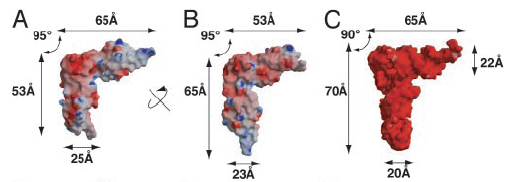Crystal structure of elongation factor P
Inquiry number
SOL-0000001225
Beamline
BL45XU (Macromolecular Crystallography II)
Scientific keywords
| A. Sample category | biology, medicine |
|---|---|
| B. Sample category (detail) | crystal, biomolecule, crystal, protein |
| C. Technique | X-ray diffraction |
| D. Technique (detail) | single crystal |
| E. Particular condition | low-T (~ liquid N2) |
| F. Photon energy | X-ray (4-40 keV) |
| G. Target information | molecular structure, structure analysis, crystal structure, function and structure, function |
Industrial keywords
| level 1---Application area | Pharmaceuticals |
|---|---|
| level 2---Target | drug design, process analytical technology (PAT) |
| level 3---Target (detail) | protein |
| level 4---Obtainable information | crystal structure, supra-molecular assemblies, absolute configuration |
| level 5---Technique | diffraction |
Classification
A80.50 Pharmaceuticals, M10.10 single crystal diffraction
Body text
Translation elongation factor P (EF-P)stimulates ribosomal peptidyltransferase activity. EF-P is conserved in bacteria and is essential for cell activity. EF-P from Thermus Thermophilus HB8 consists of three |-barrel domains that are arranged in an L shape, with 65- and 53--long arms at an angle of 95, which is reminiscent of tRNA. Most of the EF-P protein surface is negatively charged. Therefore, EF-P mimics the tRNA shape.
Figure. Structure comparison of EF-P with tRNA. (A and B) EF-P from T. thermophilus HB8 (PDB ID code 1UEB). (C)tRNAPhe from Saccharomyces cerevisiae (PDB ID code 1EVV).Surface color shows the electric charge potential; red is a negative-charged area and blue is a positive-charged area.
[ K. Hanawa-Suetsugu, S. Sekine, C. Hori-Takemoto, T. Terada, S. Unzai, J. R. H. Tame, S. Kuramitsu, M. Shirouzu and S. Yokoyama, Proceedings of National Academy of Science of the USA 101, 9595-9600 (2004), Fig. 3,
©2004 National Academy of Science ]
Source of the figure
Original paper/Journal article
Journal title
PNAS, 101(26), 2004, 9595-9600
Figure No.
3
Technique
Source of the figure
No figure
Required time for experimental setup
24 hour(s)
Instruments
References
| Document name |
|---|
| K.Hanawa-Suetsugu, S.Sekine, H.Sakai, C.Hori-Takemoto, T.Terada, S.Unzai, J.R.H.Tame, S.Kuramitsu, M.Shirouzu, S.Yokoyama, PNAS, 101(26), (2004), 9595-9600. |
Related experimental techniques
Questionnaire
This solution is an application of a main instrument of the beamline.
This solution is application of a new instrument installed in the past two years.
Ease of measurement
Middle
Ease of analysis
With a great skill
How many shifts were needed for taking whole data in the figure?
Two-three shifts
